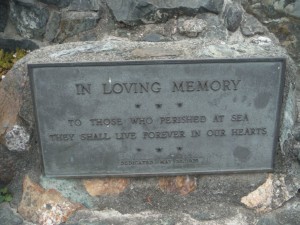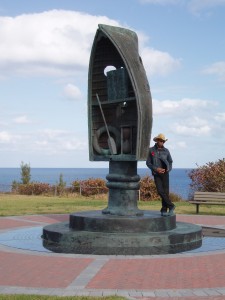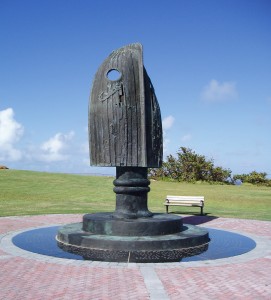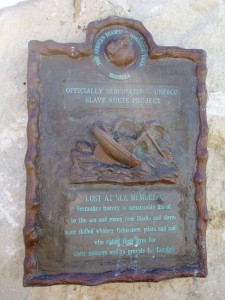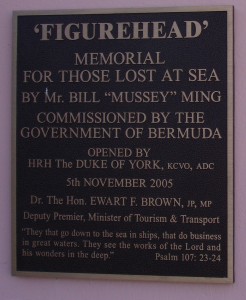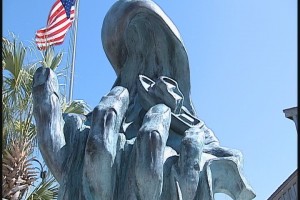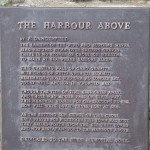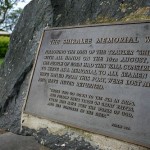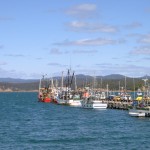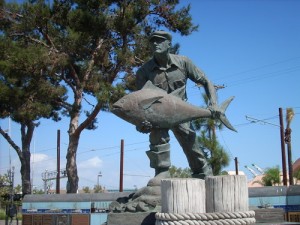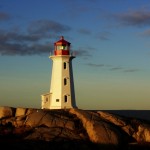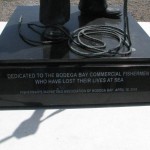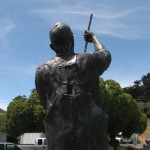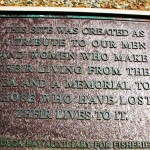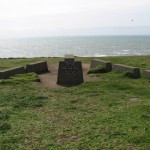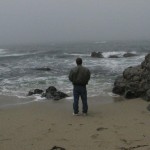Archive for the 'Commercial Fishing' Category
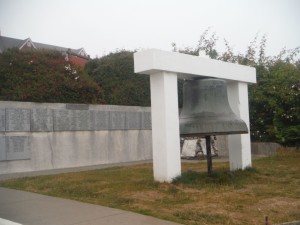 Old friend, former naval officer, and past contributor to this blog Bob Schnell (see March 2011 U.S.S. Roosevelt post) send me the photos for this post.
Old friend, former naval officer, and past contributor to this blog Bob Schnell (see March 2011 U.S.S. Roosevelt post) send me the photos for this post.
Trinidad Head, California is located in Northern California – north of the cities of Eureka and Arcata. The area has a long maritime history, from fishing to the shipping of redwood lumber to the large ports of the west coast. Below the Trinidad Head lighthouse is a memorial to those lost at sea from the local area. One addition to this memorial that I’ve never seen before is the addition of panels of locals who decided to be buried at sea. I think this adds a nice touch to a memorial located at one of the most beautiful spots in California.
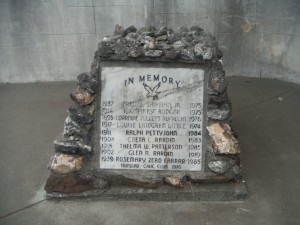
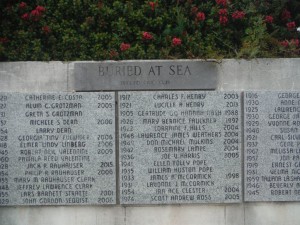
The most enjoyable and satisfying aspect of writing this blog is hearing from strangers commenting on a post or directing my attention to a memorial previously unknown to me. Recently I received an email from Nadia Ming, calling my attention to the Figurehead Memorial on St. David’s Island, Bermuda. My sincere appreciation to her for all the background information for this post. All Photographs in the post are courtesy of Nadia Ming.
The memorial was originally proposed in January 2003, when two fishermen were lost at sea in rough weather. The memorial, by Bermuda artist and native Bill Ming, was dedicated on November 5, 2005 by HRH Prince Andrew, the Duke of York.
I often speculate about the thought process of the artist when writing these posts. This post is special, however, as Nadia Ming provided me with Bill’s original vision for the project.
Maquette for Memorial for Those Lost at Sea
“As an ex-seaman who worked aboard the Queen of Bermuda I felt inspired and motivated to submit my representation of the Memorial for Those Lost at Sea. The theme of maritime life is very close to my art and ideas therefore this sculpture is intended to be a work of commemoration for the known and unknown souls lost to the tides of time yet alive through our memories and chronicles.
This memorial should honour our local fishermen/women who cast their nets and pots to scrape an existence from their catch. Bermudians lost to their loved ones as a result of storms or hurricane and the African slaves who perished during the long arduous Middle Passage.
I have tried to capture these elements, creating the spirit of a beacon that acts as a guiding and welcoming sight in times of storm and calm, a lookout for sailors who sail beyond that horizon of hope.
The form of my sculpture takes the shape of an upturned vessel, which points to the skies and stands erect on a compass due east. Barnacles, shells and a map of Bermuda tattoo the face/mask like limpets clinging to a hulks underbelly. These would stand proud of the surface providing tactile information for people with visual impairments.
Braids of rope frame a cabinet, which houses a paddle for that proverbial creek; an hourglass with sand running out and a life preserver to keep ones head above the water. Overseeing these articles shelters an open logbook that can display the names of all ”Bermudians lost at sea,” alternatively the base could also provide space for names, which would be visually accessible for people in wheelchairs.
I envisage that the final design could be produced in metal (possibly bronze) and/or stone, which would be sympathetic to the site and have durability.”
I believe Mr. Ming captured every element he envisioned in this beautiful memorial. The artist is pictured in the first picture below. I encourage everyone to learn more about Mr. Ming and his art at: http://www.billming.com/index.php
Nadia pointed out two very important additional elements of the memorial in her emails. The first was that The Figurehead Memorial is also part of The African Diaspora Heritage Trail (ADHT), which has been officially designated part of UNESCO Slave Route Project. Take the time to visit the ADHT website at: http://www.adht.bm. I think you will find yourself, like me, spending many fascinating hours learning about “the global narrative of people and culture of African descent” – and the very valuable and important effort to encourage everyone to visit these sites of historical and cultural importance and enrichment.
Information on the UNESCO Slave Route Project can be found at :http://www.unesco.org/new/en/culture/themes/dialogue/the-slave-route.
Men and women of African descent have sailed the oceans since the beginning of recorded history. The earliest known ocean voyages were from Northern Africa to Malta and Crete. During the Great Age of Sail (1600 – 1850) over 20% of all able-bodied seamen were of African descent – some were slaves, but most were free Blacks. Today they still command and crew the warships, merchant vessels, passenger ships and fishing fleets of the world – and daily face the dangers and the majesty of the open ocean.
Approximately 70 names of those lost at sea from Bermuda are engraved at the base of the memorial. All their names can be found at: http://bernews.com/2010/03/lost-at-sea-memorial-full-list-of-names/.
In closing this post, the poem below is inscribed in the open pages of the logbook on the memorial. The poet’s words were inspired by the book of Revelations of St. John the Divine, Chapter 10:5,6 – “And the angel whom I saw standing on the sea and upon the earth lifted up his hand to heaven. And swore by him that liveth for ever and ever, who created heaven and the things that are in it, and the earth and the things that are in it, that time should be no longer.”
THE END OF TIME
“Upon the restless rolling deep
That once the mighty tempest spawned;
Now lies the racing crest asleep.
Beneath that peaceful glassy plain;
All ships and men are there interred;
And all are ‘neath that blanket lain;
Tho’ strove with main now undisturbed.
Beneath that awful silent shroud;
Beneath that fearful mocking stew;
Mingled bone and steel as one
Forever wed as silten brew.
Wreckage, war and nature’s knife;
Trophies piled are theirs to be;
But wills again ‘lasting life,
Victorious, glorious, – NO MORE THE SEA”
By the late Allan E. Doughty Sr. 1922-2013
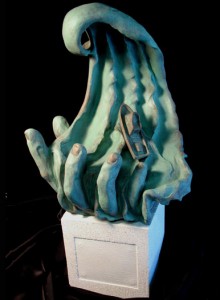 Almost all lost at sea memorials begin as a vision in the hearts and minds of family, friends, and shipmates. The journey from the initial vision of a memorial to final completion can be long and difficult, requiring constant dedication.
Almost all lost at sea memorials begin as a vision in the hearts and minds of family, friends, and shipmates. The journey from the initial vision of a memorial to final completion can be long and difficult, requiring constant dedication.
The image on the left is a small model of a proposed sculpture by Florida artist Robert Bruce Epstein entitled “The Hand of Fate”. A dedicated group of citizens of John’s Pass Village on the west central Florida coast hope to turn this beautiful concept into a permanent memorial. Families and friends of Florida fishermen lost at sea are intimately involved in this effort.
The web site for the memorial contains a listing of almost 150 individuals who died at sea sailing from the west central Florida coastal area. The remains of most of those victims are lost forever in the waters of the Gulf. These include commercial fishermen, recreational fishermen, divers, Coast Guard crews, and others. Looking through that list is a sobering experience. A fully realized memorial would be a most appropriate way to honor their memory. Perhaps some readers of this blog will be able to contribute.
Please visit the memorial’s fine website at: http://www.floridafishermenlostatsea.com/
An extensive newspaper article on the proposed memorial can be accessed at: http://www.floridafishermenlostatsea.com/pdf/times2010.pdf. This article can also be found on the memorial website.
5/26/12 – The Memorial is now completed and is beautiful. Please see the comment below from the artist Robert Bruce Epstein and these first photographs. More to follow in a future post.
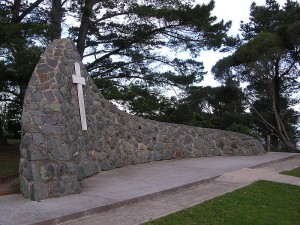 Quite often a simple design can most effectively relate the power of the sea. The Seamen’s Memorial Wall in Eden, Australia is a striking example. The wall was originally designed and built as a memorial to the fishing trawler ‘Shiralee’, lost with all souls on August 10, 1978. Today plaques dedicated to the memory of 24 New South Wales souls lost at sea are attached to the granite wall shaped like a giant wave. These plaques include the names of two sets of fathers and sons who were lost on separate occasions.
Quite often a simple design can most effectively relate the power of the sea. The Seamen’s Memorial Wall in Eden, Australia is a striking example. The wall was originally designed and built as a memorial to the fishing trawler ‘Shiralee’, lost with all souls on August 10, 1978. Today plaques dedicated to the memory of 24 New South Wales souls lost at sea are attached to the granite wall shaped like a giant wave. These plaques include the names of two sets of fathers and sons who were lost on separate occasions.
Eden is located on Twofold Bay, a beautiful refuge from the Tasman Sea to the East. Eden was for generations a leading port of the whaling industry. It’s location was a perfect spot to intercept whales migrating from the Antarctic to the waters of the Great Barrier Reef. Eden remains a vibrant hub for the Australian fishing industry – and a place of extraordinary natural beauty, befitting its name. But the beauty and peace of any port, unfortunately, often becomes the final memory for some mariners. Fishermen who take to the seas always do so at great risk – some never to return to their personal Eden…
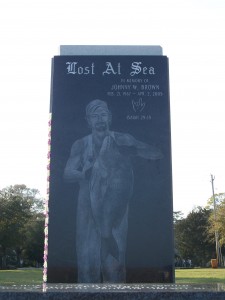
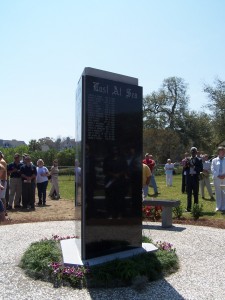 My last few months of U.S. Navy flight training were spent in Brunswick, Georgia. It was easy to fall in love with the Golden Isles area – as well as the entire coast of Georgia, and South & North Carolina. The beautiful beaches, salt marshes, daily afternoon thunderstorms, warm Atlantic waters, and abundance of wildlife were a constant feast for the senses for someone from the high desert of Nevada. And of course the seafood – the wonderful seafood.
My last few months of U.S. Navy flight training were spent in Brunswick, Georgia. It was easy to fall in love with the Golden Isles area – as well as the entire coast of Georgia, and South & North Carolina. The beautiful beaches, salt marshes, daily afternoon thunderstorms, warm Atlantic waters, and abundance of wildlife were a constant feast for the senses for someone from the high desert of Nevada. And of course the seafood – the wonderful seafood.
Everything has a price, however. The seafood that we all enjoy is the product of hard and dangerous work performed by brave and dedicated professionals. In the beautiful town of Murrells Inlet, South Carolina is a lost at sea memorial first envisioned as a tribute to one of those brave souls. Johnny W. Brown was a commercial fisherman sailing out of Murrells Inlet. On April 2, 2005 Johnny’s vessel was hit by a large rouge wave. His shipmates were rescued, but Johnny was lost to the Atlantic.
Johnny Brown died at the young age of 38, but there can be no doubt as to the love and respect he had to have earned in his short life. Family and friends arranged to have a memorial built to Johnny – and to others from the coastal areas of South Carolina lost at sea from whatever cause. On the first anniversary of Johnny’s loss a monument was unveiled in Morse Park Landing in Murrells Inlet. The monument consists of three black granite sides. On the side facing the jetties of Murrells Inlet is a life sized etching of Johnny. The other two sides are reserved for additional names of those lost at sea. When unveiled the monument contained 17 additional names. More have been added since – and will continue to be added, if required, annually.
This perhaps, is the purest type of lost at sea monument – a simple and beautiful memorial dedicated by family and friends to the eternal memory of loved ones gone, but most certainly not forgotten.
When I first looked at a photograph of the original 17 names added for the unveiling I was struck to see my own name on the panel. I was fascinated to read the story of the Dan Jenkins honored on the panel at the memorial web site. He was born in 1914 and lost at sea on the shrimp boat ‘Lottie C’ in October 1957. Perhaps he is a distant relative. Perhaps we simply share a name. Either way, I won’t forget where his name and memory reside.
Please visit the website for the Lost at Sea Memorial at http://www.lostatseamemorial.com/. There you can read the history of the monument, learn about all the people remembered on the panels, and obtain an application to add a name to the panels.
And please visit the fascinating YouTube video that details the construction of the monument at http://www.youtube.com/watch?v=5KOUwEhLdqg. The dedication of everyone is apparent and the beauty of the memorial site and surrounding area very evident. It’s a beautiful video about a beautiful memorial.
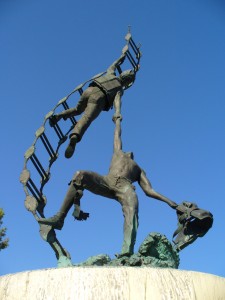 One new photograph revisiting an old post and one new memorial not previously discussed in earlier posts are today’s topics. Both of these memorials can be found near the waterfront in San Pedro, California.
One new photograph revisiting an old post and one new memorial not previously discussed in earlier posts are today’s topics. Both of these memorials can be found near the waterfront in San Pedro, California.
I previously posted a discussion of the impressive Jacob’s Ladder sculpture by Jasper D’Ambrosi. A reader of this blog has graciously provided me with a beautiful photograph of the memorial. Tamara Becker presently serves as a Second Mate and Chief Mate Unlimited on commercial ships. She also has a BA degree in Maritime History, extensive experience at sea, and a keen photographer’s eye. Of all the photographs I have seen of this memorial, Tamara’s is the best. The tenuous nature of the sailors’ hold on the ladder, the water at the lower sailor’s feet, the constant sway and twists of the Jacob’s Ladder, and the life and death tension of the entire situation is vibrantly conveyed in her superb photograph. It is my pleasure to share it with everyone. Thanks Tamara.
Another memorial in San Pedro is the Fishing Industry Memorial. Southern California became a canning location for sardines, mackerel, bluefin tuna, yellowfin tuna, and albacore in the late 1800s. Fresh fish markets became common in San Pedro south to San Diego in the early 1900s. Large fleets of purse seiners could be found in the ports of Southern California throughout the 20th Century. The Fishing Industry Memorial pays tribute to the men who lived and died bringing tuna to market. The fine photograph is courtesy of Manuel Ortiz (mortis24 on Panoramio). Thanks Manuel.
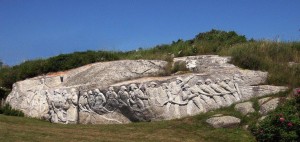 Among the most beautiful places on earth are the Canadian Maritime Provinces. Their scenic beauty is equaled by the kindness and hospitality of their citizens.
Among the most beautiful places on earth are the Canadian Maritime Provinces. Their scenic beauty is equaled by the kindness and hospitality of their citizens.
The Maritimes possess a seafarer history matched by few other locations. Elegant and timeless ships have been designed and built in the shipyards of the Maritimes – such as the “Marco Polo” from New Brunswick, the “Bluenose” from Nova Scotia, and the rum runner “Ellie J. Banks” from Prince Edward Island. The fishing industry gave life to the Maritimes. One can only hope that the lobsters remain plentiful and that the cod will someday return in great numbers.
The Maritimes have also been the location of some of the great tragedies at sea. My next few posts will discuss some of these, but I’d like to begin these posts with a thing of beauty in Peggy’s Cove, Nova Scotia.
William Edward deGarthe was born in Helsinki, Finland. He emigrated to Canada in 1926, moved to Halifax in 1945, and eventually settled permanently in the beautiful village of Peggy’s Cove in 1955. He was a painter and sculptor, his artistic work devoted to maritime subjects after his move to Peggy’s Cove. His “Fisherman’s Monument” was sculpted out of a 100 foot granite face of rock below his home. It depicts thirty-two fishermen and their wives and children enveloped in the wings of a guardian angel. The sculpture and his home (now a museum to his work) were donated to the province of Nova Scotia after his death. It is a beautiful piece of art – I’m certain meant to honor both the living and those lost at sea.
A new and well-conceived memorial to those lost at sea was recently dedicated close to my home in Northern California. The Commercial Fisherman Memorial is located at Spud Harbor in Bodega Bay, California. The statue pays tribute to the commercial fisherman lost at sea after sailing from Bodega Bay. These include those fishing for salmon, crab, abalone, and rockfish over the past two centuries. Names of lost fishermen will be added to the memorial beginning in April 2011 – and I suspect for many years to come.
The fishing industry is in dire straits around the world. The reasons are well known – overfishing, man-made and natural disasters, global climate change, and pollution. Fishermen work harder, longer, and take more risks for a continuing reduced reward. One can only hope that their fortunes change in the coming decades. Memorials such as the Bodega Bay Memorial and others around the world serve to remind us all of the sacrifices made for centuries by commercial fishermen.
If you’re near Bodega Bay, I encourage you to take the hike around Bodega Head. Placed on a cliff looking west towards the Pacific is another small memorial to the fishermen of Bodega Bay. Gazing at the Pacific from the memorial site is always a reminder of the risks taken every day by commercial fishermen. Walk down to the water’s edge from the memorial on a less than perfect day and the reality of what commercial fisherman face daily can begin to be appreciated.

